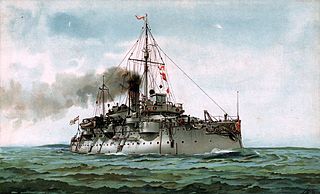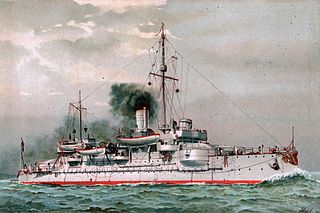
SMS Siegfried was the lead ship of the six-member Siegfried class of coastal defense ships built for the German Imperial Navy. Her sister ships were Beowulf, Frithjof, Heimdall, Hildebrand, and Hagen. Siegfried was built by the Germaniawerft shipyard between 1888 and 1890, and was armed with a main battery of three 24-centimeter (9.4 in) guns. She served in the German fleet throughout the 1890s and was rebuilt in 1903 - 1904. She served in the VI Battle Squadron after the outbreak of World War I in August 1914, but saw no action. Siegfried was demobilized in 1915 and used as a barracks ship thereafter. She was ultimately broken up for scrap in 1920.

SMS Ägir was the second and final member of the Odin class of coastal defense ships built for the Imperial German Navy. She had one sister ship, Odin. Ägir was named for the norse god, and was built by the Kaiserliche Werft in Danzig between 1893 and 1896. She was armed with a main battery of three 24-centimeter (9.4 in) guns. She served in the German fleet throughout the 1890s and was rebuilt in 1901–1903. She served in the VI Battle Squadron after the outbreak of World War I in August 1914, but saw no action. Ägir was demobilized in 1915 and used as a tender thereafter. After the war, she was rebuilt as a merchant ship and served in this capacity until December 1929, when she was wrecked on the island of Gotland.

SMS Deutschland was the second and final ship of the Kaiser-class ironclads; SMS Kaiser was her sister ship. Named for Germany, the ship was laid down in the Samuda Brothers shipyard in London in 1872. The ship was launched in September 1874 and commissioned into the German fleet in July 1875. Deutschland mounted a main battery of eight 26 cm (10.2 in) guns in a central battery amidships. She was the last capital ship built for the German Navy by a foreign ship-builder; all subsequent ships were built in Germany.

The Brandenburg class consisted of four pre-dreadnought battleships built for the German Kaiserliche Marine, the first modern battleships of the fleet. The four ships of the class—Brandenburg, Wörth, Weissenburg, and Kurfürst Friedrich Wilhelm—were the first ocean-going capital ships built for the German fleet in nearly two decades, owing to reluctance in the Reichstag to fund large projects. They followed a series of small coastal defense ships, and though in retrospect they anticipated the buildup that created the High Seas Fleet, they were ordered as part of a construction program that reflected the strategic and tactical confusion that affected many navies in the 1880s. The design process that resulted in the Brandenburg class was very lengthy, with proposals that ranged from outdated casemate ships to versions with two twin-gun turrets placed side by side. The designers ultimately settled on ships that were armed with an unusual main battery of six 28 cm (11 in) guns at a time when all foreign battleships were built with four or fewer heavy guns.

The Sachsen class of armored corvettes was a class of four ships built by the Imperial German Navy in the late 1870s to early 1880s. The ships—Sachsen, Bayern, Württemberg, and Baden—were designed to operate as part of an integrated coastal defense network. The ships were intended to sortie from fortified bases to break up an enemy blockade or landing attempt. Armed with six 26 cm (10.2 in) guns, they were also intended to fight hostile ironclads on relatively equal terms.

SMS Schwaben was the fourth ship of the Wittelsbach class of pre-dreadnought battleships of the German Imperial Navy. Schwaben was built at the Imperial Dockyard in Wilhelmshaven. She was laid down in 1900, and completed in April 1904. Her sister ships were Wittelsbach, Zähringen, Wettin and Mecklenburg; they were the first capital ships built under the Navy Law of 1898, championed by Admiral Alfred von Tirpitz. Schwaben was armed with a main battery of four 24-centimeter (9.4 in) guns and had a top speed of 18 knots.

Alexander Graf von Monts de Mazin was an officer in the Prussian Navy and later the German Imperial Navy. He saw action during the Second Schleswig War at the Battle of Jasmund on 17 March 1864 as the commander of the paddle steamer SMS Loreley. He served in a variety of roles through the 1860s and 1870s, including as the commander of the ironclad SMS Grosser Kurfürst, which sank after being rammed accidentally by the ironclad König Wilhelm on the former's maiden voyage in May 1875. Monts was ultimately cleared of wrongdoing in four courts-martial held by the chief of the German Imperial Admiralty, Albrecht von Stosch in an attempt to drive him from the navy. In 1883, Stosch was replaced by Leo von Caprivi, who appointed Monts the chief of the North Sea Naval Station. In 1888, he became the third chief of the Admiralty after Caprivi retired, though Monts remained in the position for just six months before he died.

The Siegfried class was a group of six coastal defense ships built by the German Kaiserliche Marine in the late 19th century. The ships were intended to protect the German coastline from naval attacks. The class comprised the lead ship Siegfried, along with her sisters Beowulf, Frithjof, Heimdall, Hildebrand, and Hagen. All six ships were named after Norse mythological figures. Two further vessels, the Odin class, were built to a similar design but were not identical.

The Odin class was a pair of coastal defense ships built for the German Kaiserliche Marine in the late 19th century. The class comprised two ships: Odin, named after the Norse god Odin, and Ägir, named after the Norse god of the same name. The ships were very similar to the preceding Siegfried-class coastal defense ships, and are sometimes considered to be one class of ships.

SMS Heimdall was the fourth vessel of the six-member Siegfried class of coastal defense ships built for the German Imperial Navy. Her sister ships were Siegfried, Beowulf, Frithjof, Hildebrand, and Hagen. Heimdall was built by the Kaiserliche Werft in Wilhelmshaven between 1891 and 1894, and was armed with a main battery of three 24-centimeter (9.4 in) guns. She served in the German fleet throughout the 1890s and was rebuilt in 1900–1902. She served in the VI Battle Squadron after the outbreak of World War I in August 1914, but saw no action. Heimdall was demobilized in 1915 and used as a barracks ship thereafter. She was ultimately broken up for scrap in 1921.

SMS Beowulf was the second vessel of the six-member Siegfried class of coastal defense ships built for the German Imperial Navy. Her sister ships were Siegfried, Frithjof, Heimdall, Hildebrand, and Hagen. Beowulf was built by the AG Weser shipyard between 1890 and 1892, and was armed with a main battery of three 24-centimeter (9.4 in) guns. She served in the German fleet throughout the 1890s and was rebuilt in 1900 – 1902. She served in the VI Battle Squadron after the outbreak of World War I in August 1914, but saw no action. Beowulf was demobilized in 1915 and used as a target ship for U-boats thereafter. She was ultimately broken up for scrap in 1921.

SMS Frithjof was the third vessel of the six-member Siegfried class of coastal defense ships built for the German Imperial Navy. Her sister ships were Siegfried, Beowulf, Heimdall, Hildebrand, and Hagen. Frithjof was built by the AG Weser shipyard between 1890 and 1893, and was armed with a main battery of three 24-centimeter (9.4 in) guns. She served in the German fleet throughout the 1890s and was rebuilt in 1900 - 1902. She served in the VI Battle Squadron after the outbreak of World War I in August 1914, but saw no action. Frithjof was demobilized in 1915 and used as a barracks ship thereafter. She was rebuilt as a merchant ship in 1923 and served in this capacity until she was broken up for scrap in 1930.

SMS Hildebrand was the fifth vessel of the six-member Siegfried class of coastal defense ships built for the German Imperial Navy. Her sister ships were Siegfried, Beowulf, Frithjof, Heimdall, and Hagen. Hildebrand was built by the Kaiserliche Werft at Kiel between 1890 and 1893, and was armed with a main battery of three 24-centimeter (9.4 in) guns. She served in the German fleet throughout the 1890s and was rebuilt in 1900–1902. She served in the VI Battle Squadron after the outbreak of World War I in August 1914, but saw no action. Hildebrand was demobilized in 1915 and used as a barracks ship thereafter. She ran aground while en route to the Netherlands for scrapping in 1919, and was eventually broken up in situ in 1933.

SMS Hagen was the final vessel of the six-member Siegfried class of coastal defense ships built for the German Imperial Navy. Her sister ships were Siegfried, Beowulf, Frithjof, Heimdall, and Hildebrand. Hagen was built by the Kaiserliche Werft in Kiel between 1891 and 1893, and was armed with a main battery of three 24-centimeter (9.4 in) guns. She served in the German fleet throughout the 1890s and was rebuilt in 1900 - 1902. She served in the VI Battle Squadron after the outbreak of World War I in August 1914, but saw no action. Hagen was demobilized in 1915 and used as a barracks ship thereafter. She was ultimately sold for scrap in 1919 and subsequently dismantled.

SMS Odin was the lead ship of her class of coastal defense ships built for the Imperial German Navy. She had one sister ship, Ägir. Odin, named for the eponymous Norse god, was built by the Kaiserliche Werft in Danzig between 1893 and 1896, and was armed with a main battery of three 24-centimeter (9.4 in) guns. She served in the German fleet throughout the 1890s and was rebuilt in 1901–1903. She served in the VI Battle Squadron after the outbreak of World War I in August 1914, but saw no action. Odin was demobilized in 1915 and used as a tender thereafter. After the war, she was rebuilt as a merchant ship and served in this capacity until 1935, when she was broken up for scrap.

SMS Baden was one of four Sachsen-class armored frigates of the German Kaiserliche Marine. Her sister ships were Sachsen, Bayern, and Württemberg. Baden was built in the Kaiserliche Marine in Kiel from 1876 to 1883. The ship was commissioned into the Imperial Navy in September 1883. She was armed with a main battery of six 26 cm (10.2 in) guns in two open barbettes.















